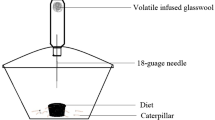Abstract
Insects have evolved a potpourri of mechanisms for manipulating the allelochemicals that fortify their preferred host plants. A concatenation of physiological and biochemical events frequently follows the ingestion of a toxic natural product and can eventuate in a variety of fates for the compound. A particular allelochemical may be absorbed, metabolized, and sequestered, whereas the fates of concomitant natural products may be very different. Some compounds may be directly excreted in the faeces and their concentration will thus mirror that in the plant. In other cases, selective absorption and sequestration combine to biomagnify minor constituents so that the concentration of these sequestered compounds in insect tissues differs drastically from their concentrations in the host plants.
The acridid Romalea guttata is utilized in this paper as a paradigmatic insect which eclectically processes ingested allelochemicals from a wide range of host plants. This generalist herbivore is eminently suitable as a model because it feeds on plants containing a veritable pharmacopoeia of toxic compounds. The proven sequestrative potential of its defensive glands further qualifies R. guttata as an excellent candidate for determining the fates of toxic phytochemicals. An analysis of this insect’s processing strategies for the compounds ingested after feeding on catnip (Nepeta cataria) reveals that for R. guttata variety is the spice of herbivorous life. The results of this investigation persuasively demonstrate that each insect species—and the phytochemical mixture that it ingests—must be regarded as a unique evolutionary case that constitutes a distinctively idiosyncratic phenomenon.
Résumé
Les insectes ont développé un potpourri de mécanismes pour manipuler les composés qui fortifient leurs plantes préférées. Un enchaînement d’évenements physiologiques et biochimiques découle fréquemment de l’ingestion d’un produit naturel et toxique et peut donner au composé des fortunes diverses. Un composé particulier peut àtre absorbé, transformé par métabolisme, et isolé, alors que les fortunes des produits naturels comcomitants peuvent àtre très différents. Certains composés peuvent àtre excrétés directement dans les fèces et leur concentration correspondra à celui de la plante. Dans les autres cas, l’absorption et l’isolement sélectifs se combinent pour augmenter biologiquement les constituants mineurs de sorte que la concentration des composés isolés dans les tissues de l’insecte différe radicalement de la concentration qui existe dans les plantes préférées. Dans cet article on examine la sauterelle Romalea guttata comme modèle qui utilise éclectiquement les composés ingérés d’un grand choix de plantes préférées.
Similar content being viewed by others
References
Blum M. S. (1983) Detoxication, deactivation, and utilization of plant compounds by insects. In Plant Resistance to Insects (Edited by Hedin P. A.), pp. 265–275. ACS Symposium Series, No. 208, American Chemical Society, Washington.
Blum M. S., Rivier L. and Plowman T. (1981) Fate of cocaine in the lymantriid Eloria noyesi, a predator of Erythroxylum coca. Phytochem. 20, 2499–2500.
Brower L. P., Seiber J. N., Nelson C. J., Lynch S. P., Hoggard M. P. and Cohen J. A. (1984) Plant-determined variation in cardenolide content and thin-layer chro-matography profiles of monarch butterflies, Danaus plexippus reared on milkweed plants in California. 3: Asclepias califomica. J. Chem. Ecol. 10, 1823–1857.
Duffey S. S. (1980) Sequestration of plant natural products by insects. A. Rev. Ent. 25, 447–477.
Duffey S. S. and Blum M. S. (1977) Phenol and guaiacol: Biosynthesis, detoxication, and function in a polydesmid millipede, Oxidus gracilis. Insect Biochem. 7, 57–65.
Duffey S. S. and Scudder G. G. E. (1974) Cardiac glycosides in Oncopeltus fascialus (Dallas) (Hemiptera: Ly-gaeidae)—I. The uptake and distribution of natural cardenolides in the body. Can. J. Zool. 52, 283–290.
Eisner T. (1964) Catnip: Its raison d’être. Science 146, 1318–1320.
Eisner T., Hendry L. B., Peakall D. B. and Meinwald J. (1971) 2,5-Dichlorophenol (from ingested herbicide?) in defensive secretion of grasshopper. Science 172, 277–278.
Fraenkel G. S. (1959) The raison d’être of secondary plant substances. Science 129, 1466–1470.
Jones C. G., Hess T. A., Whitman D. W., Silk P. J. and Blum M. S. (1986) Idiosyncratic variation in chemical defenses among individual generalist grasshoppers. J. Chem. Ecol. 12, 749–761.
Jones C. G., Hess T. A., Whitman D. W., Silk P. J. and Blum M. S. (1987) Effects of diet breadth on autogenous chemical defense of a generalist grasshopper. J. Chem. Ecol. 13, 283–297.
Nishio S. (1980) The fates and adaptive significance of cardenolides sequestered by larvae of Danaus plexippus (L.) and Cycnia inopinatus (Hy. Edwards). Ph.D. thesis, University of Georgia.
Regnier F. E., Eisenbraun E. J. and Waller G. R. (1967) Nepetalactone and epinepetalactone from Nepeta cataria L. Phytochem. 6, 1271–1280.
Rothschild M. (1972) Secondary plant substances and warning colouration in insects. In Insect/Plant Relationships (Edited by van Emden H.), pp. 59–83. Blackwells, Oxford and London.
Rothschild M., Aplin R. T., Cockrum P. A., Edgar J. A., Fairweather P. and Lees R. (1979) Pyrrolizidine alkaloids in arctiid moths (Lep.) with a discussion on host plant relationships and the role of these secondary plant substances in the Arctiidae. Biol. J. Linn. Soc. 12, 305–326.
Rothschild M., von Euw J., Reichstein T., Smith D. A. S. and Pierre J. (1975) Cardenolide storage in Danaus chrysippus (L.) with additional notes on D. plexippus (L.). Proc. Roy. Soc. Lond. (B) 190, 1–31.
Scudder G. G. E., Moore L. V. and Isman M. B. (1986) Sequestration of cardenolides in Oncopeltus fascialus: Morphological and physiological adaptations. J. Chem. Ecol. 12, 1171–1187.
Seiber J. N., Tuskes P. M., Brower L. P. and Roeske C. N. (1980) Pharmacodynamics of some individual milkweed cardenolides fed to larvae of the monarch butterfly (Danaus plexippus L.). J. Chem. Ecol. 6, 321–339.
Author information
Authors and Affiliations
Rights and permissions
About this article
Cite this article
Blum, M.S., Whitman, D.W., Severson, R.F. et al. Herbivores and Toxic Plants: Evolution of a Menu of Options for Processing Allelochemicals. Int J Trop Insect Sci 8, 459–463 (1987). https://doi.org/10.1017/S1742758400022487
Received:
Published:
Issue Date:
DOI: https://doi.org/10.1017/S1742758400022487




